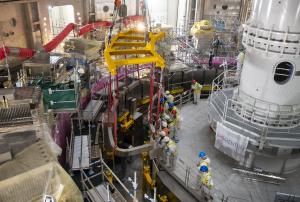First of 18 lowered
In all tokamak devices, ITER included, small deviations in the shape or position of the magnets cause unwanted field perturbations that can affect plasma stability and confinement. Correcting these "magnetic field errors" in ITER is the job of the correction coils—18 small superconducting coils inserted between the major toroidal and poloidal field systems. The first correction coil was lowered into place on 21 October.
Eighteen correction coils—six top, six side and six bottom—will act in pairs to correct, or reduce, the most troublesome field errors. Based on a build-to-print design developed by the ITER Organization, the Chinese Domestic Agency and its contractor ASIPP (Institute of Plasma Physics, Chinese Academy of Sciences) are procuring the coils. The first two bottom correction coils arrived on site at ITER in December 2020; since then, four other bottom coils have been delivered.
On site, each coil undergoes site acceptance tests including electrical tests, dimensional surveys, leak tests and weld inspections. For bottom coils BCC/4 and BCC/5, these tests were completed this month.
"We know the as-built position of the first two poloidal field coils in the pit; we needed to work back from that to ready the temporary supports and plan the lift," says Josep Pallisa, assembly engineer in the Magnet Section. "In the crowded environment of the lower Tokamak pit, the bottom correction coils and their supports have only a small sliver of space between poloidal field coil #6, poloidal field coil #5, lower magnet feeders, and staging platforms."
The lift of BCC/4 on Thursday 21 October went according to plan. The second correction coil, BCC/5, will be positioned in the pit on 26 October, followed in the coming months by two other bottom correction coil pairs. In the final machine geometry, the correction coils will be attached to the toroidal field coil superstructure.










